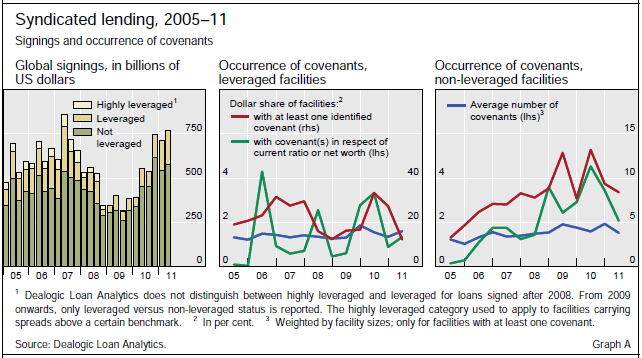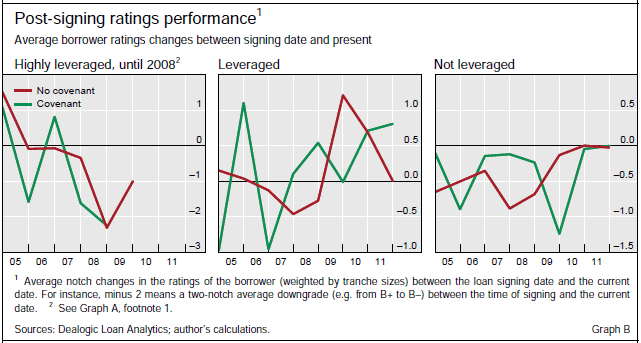Have lenders become complacent in the market for syndicated loans? Evidence from covenants
(Extract from pages 26-27of BIS Quarterly Review, September 2011)
The market for syndicated loans, a very significant source of funding for corporate borrowers, has recovered from its collapse during the financial crisis. By early 2011, financing was available at close to pre-crisis conditions.
Syndicated loan signing volumes bounced back from the nadir reached in the aftermath of the crisis, rising from $314 billion in the third quarter of 2009 to $766 billion in the second quarter of 2011 (Graph A, left-hand panel). Refinancings generated $405 billion of signings in the second
quarter of 2011, or 53% of the total, as borrowers sought to replace facilities obtained during the crisis at less attractive conditions. Issuance of leveraged loans,1 which had dropped sharply, has also rebounded. A number of large banks have resumed lending, as emergency liquidity and rescue operations helped alleviate funding constraints and shore up bank balance sheets. Activity on secondary markets also revived, suggesting that investors are willing to absorb larger amounts of loan exposure.
A number of measures indicate that financing conditions in the syndicated loan market have become looser since 2009 and are now comparable to or more favourable than the pre-crisis terms observed from the early 2000s.
First, spreads over Libor have declined, average maturities have lengthened and facility sizes have increased. The dollar share of collateralised tranches has also fallen slightly. Leveraged borrowers worldwide paid an average spread (weighted by tranche sizes) over Libor of 339 basis points in the second quarter of 2011, non-leveraged borrowers 144 basis points. That is still 100-150 basis points above the extraordinarily low pre-crisis levels, but only about half as high as the peaks reached during the crisis. These trends can be consistently observed for a number of different leverage classes, currencies, ratings classes and regions.
Second, "covenant-lite" loans have accounted for an increasing share of signings. Covenants are contract clauses that entitle lenders to impose penalties (eg a surcharge in the spread) or to accelerate the repayment of the loan if the borrower undertakes actions that might diminish the value of the collateral (such as selling or transferring assets), or fails to keep commitments (such as paying on time or keeping certain financial ratios above a given threshold). In a covenant-lite facility, the lender waives these clauses, thus enjoying less protection if the borrower meets with financial difficulties. As covenants can take many forms, aggregating them into a single measure is difficult. Nonetheless, based on the literature, it is possible to construct a number of indicators for covenant intensity: the share as a percentage of total dollar amounts of facilities with at least one identifiable covenant (Graph A, red lines in the centre and right-hand panels); the average number of different financial covenants per facility2 (for those facilities which have at least one covenant, blue lines); and the dollar share of facilities with at least one covenant requiring the borrower's current ratio,3 net worth or tangible net worth to remain above a certain threshold (green lines). 4 Admittedly, these indicators are rather noisy, showing large fluctuations within a year, particularly during crises when issuance is low. That said, all three indicators point to a drop in covenant usage in recent quarters, after an increase between 2008 and 2010 that followed a steady decline during the pre-crisis years. This has happened across regions and leverage classes.
Borrowers that were granted covenant-lite facilities during the height of the crisis have (for now) performed relatively well. Graph B shows better post-signing borrower ratings performance since 2009 for facilities without covenants (red lines) than for loans with covenants (green lines). Leveraged covenant-lites were associated with more borrower upgrades and non-leveraged covenant-lites with fewer downgrades. That said, this trend has recently started to reverse, which is reminiscent of the pre-crisis phase between 2000 and 2007-08 when covenant-lites exhibited a worse performance than facilities with covenants. While these comparisons need to be interpreted with caution, it is fair to conclude that, during crisis times, lenders are more likely to discriminate in favour of the better risks when waiving covenants. Besides, covenant-lite structures can help borrowers survive financial troubles, in that fewer defaults and penalties are mechanically triggered.
All in all, even as investor sentiment may have started turning in July-August, the above results suggest that financing conditions on the market for syndicated loans have loosened since the height of the crisis. For the United States, this is in keeping with the Federal Reserve Board's
Senior Loan Officer Opinion Survey on Bank Lending Practices, which has indicated since 2009 that a falling net fraction of domestic banks is tightening standards or raising spreads on commercial and industrial loans.
1 This box relies on the definition of Dealogic Loan Analytics for leveraged loans, which is revised annually. Over time the criteria have included borrower financial leverage and loan spreads above a certain threshold, ratings below a certain level, and loan purpose (in particular LBOs). Every loan is classified according to the definition which was valid when it was signed. It is not possible to reclassify earlier loans when the definition changes.
2 See M Puri and S Drucker, "On loan sales, loan contracting and lending relationships", Review of Financial Studies, vol 22, no 7, 2009 and N Mora, "Lender exposure and effort in the syndicated loan market", Federal Reserve Bank of Kansas City Working Papers, no RWP 10-12, September 2010.
3 Current assets divided by current liabilities.
4 S Chava and M Roberts, "How does financing impact investment? The role of debt covenants", Journal of Finance, vol 6, no 5, October 2008, give precedence to these two types of covenants over others, as they have the advantage that they are used relatively frequently and the associated accounting measures are standardised and unambiguous. Other types of covenants, such as those applied to EBITDA, are more complicated, notably because the definition of debt they refer to is not standardised.


